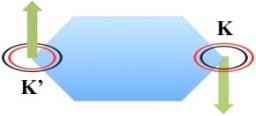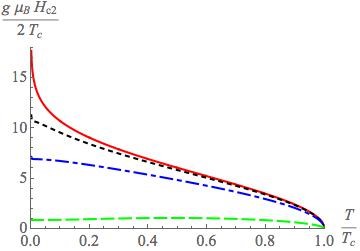Transition metal dichalcogenide (TMDC) monolayers are recently discovered two-dimensional (2D) semiconductors with a hexagonal lattice structure similar to graphene, but with two inequivalent sites in the unit cell. Like graphene, these materials exhibit a valley degree of freedom and have minima/maxima of conduction/valence bands at the corners K and K’=−K of the Brillouin zone. Unlike graphene, however, the absence of inversion symmetry allows for a large, direct band gap, making them promising candidates for a new generation of transistors. Due to the heavy constituent atoms, TMDC monolayers exhibit a very large intrinsic spin-orbit coupling (SOC), often called Ising SOC, which acts as an effective Zeeman field perpendicular to the plane of the material with opposite orientations in the two valleys (Figure 1). As a consequence, a large valley-dependent spin-splitting occurs, opening the door for novel applications in spintronics and so-called valleytronics.

Figure 1. The so-called Ising spin-orbit coupling in TMDC monolayers acts as an effective out-of-plane Zeeman field with opposite directions in the K and K’ valleys.
The coupling between the spin and valley degrees of freedom has remarkable repercussions also for the superconducting properties of doped TMDCs. As shown in recent experiments, the in-plane upper critical field greatly surpasses the so-called Pauli limit. Researchers at our laboratory established the theory of the upper critical field for Ising superconductors at arbitrary disorder strength, assuming a conventional s-wave Cooper pairing. They showed that Ising superconductivity results in an unusually large enhancement of the critical field. In the absence of intervalley scattering, the critical field diverges at low temperature (Figure 2). When intervalley scattering is at play, it provides an effective spin-flip scattering mechanism and leads to the saturation of the critical field, consistent with the experimental findings.

Figure 2. In the absence of intervalley scattering, the upper critical field diverges at low temperature (solid line). Weak intervalley scattering suppresses this divergence (dotted line). In the presence of strong intervalley scattering, one recovers the upper critical field of a conventional superconductor without spin-orbit coupling (dashed line). The dash-dotted line, corresponding to an intervalley scattering rate of the same order of magnitude as the superconducting gap, provides a good fit to the experimental findings in MoS2.
Understanding the role of impurities is important for future applications of TMDCs and their incorporation into van der Waals heterostructures. The doping techniques used to prepare the superconducting samples, as well as the defects in the crystal lattice could be the source of significant disorder. These theoretical results therefore contribute to assess their potential for applications such as in superconducting spintronics.
This work was supported by the Laboratoire d’excellence LANEF in Grenoble (ANR-10-LABX-51-01) and by the ANR through the grant ANR-16-CE30-0019.